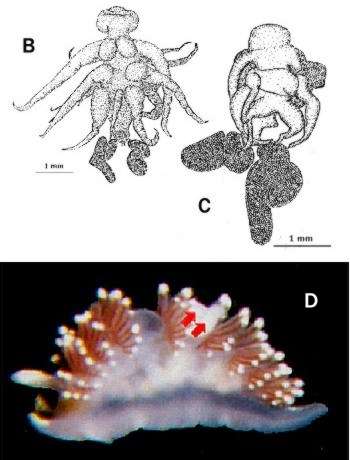

Opisthobranch parasites - the copepod Ismaila
PHOTO
A. Thecacera darwini showing egg-sacs of Ismaila sp.1 protruding behind the gill circle. B. Ismaila sp. 1. - dorsal view of female. C. Ismaila sp. 3 - dorsal view of female. D. Flabellina sp. showing egg-sacs of Ismaila sp.3 protruding through body wall. Photos & Illustrations: Michael Schroedl.
SEE ALSO:
• Comparison of 2 species of Ismaila
• Ismaila belciki, parasite of Janolus fuscus
Copepods of the family Splanchnotrophidae are known to be obligate and highly specialized parasites of shell-less opisthobranch molluscs since the last century. There is, however, very little knowledge about their anatomy, occurrence, infection rates, and relationships to their hosts.
In a study of 2257 Chilean and Argentinian opisthobranchs, from 47 species, we have shown that endoparasites of the genus Ismaila Bergh, 1867 are surprisingly common. Infection rates are low in most of the 13 Chilean host species, but reach up to 100 % in some such as Thecacera darwini Pruvot-Fol, 1950, which has the highest infection rates by splanchnotrophids ever documented.
Having such a large number of parasites from different Chilean hosts to study, our aim was
(1) to clarify the poorly known (micro)structure of body appendages, especially the mouthparts, of several Ismaila species using SEM,
(2) to use morphological and biological data such as infection rates, the parasites' position in the hosts, and their effects on the hosts, to distinguish the parasites of different host species,
(3) to conclude on possible host-specifity and different modes of host-parasite relationships.
(4) to analyze the phylogeny of both the Splanchnotrophidae and their opisthobranch hosts, and then attempt to analyse the evolution of this special association.
From this study we have concluded that:
1. There is an array of Ismaila species in Chile, which can be distinguished on morphological and biological characters.
2. Ismaila spp. in Chile are strictly host-specific.
3. Certain Chilean host species appear to have very high infection rates.
4. Parasites of the genus Ismaila are often large compared to their hosts.
5. Ismaila species all have the same kind of setigerous mouthparts and thus most likely are not tissue-feeders (as the name 'splanchnotrophids' inplies), but haemolymph-suckers.
6. Effects of parasitism on different host-species vary widely, from no visible effect to sterilisation.
While having resolved many of the major points for some Chilean Ismaila species (see separate page), more information and, in particular, more splanchnotrophid material of different genera from other parts of the world, is needed to do a comprehensive phylogenetic and evolutionary study. Any suggestions and help would be highly welcome.
Michael Schrödl
U. Haumayr
If you have specimens or information on similar animals from anywhere in the world, please let Michael know at: schroedl@zi.biologie.uni-muenchen.de
References:
•BELCIK, F.P. 1981. The male of Ismaila monstrosa Bergh, 1867 (Copepoda, Splanchnotrophidae). Crustaceana 40: 16-25.
•BERGH, R. 1867. Phydiana lynceus og Ismaila monstrosa. Videnskabelige Meddelelser fra Dansk Naturhistorisk Forening i Kobenhavn 1866: 97-130.
•HO, J.S. 1981. Ismaila occulta, a new species of poecilostomatoid Copepod parasitic in a dendronotid Nudibranch from California. Journal of Crustacean Biology 1: 130-136.
•JENSEN, K. R. 1987. Ismaila monstrosa Bergh (Copepoda: Splanchnotrophidae) found parasitizing in Ercolania funerea (Costa) (Gastropoda: Ascoglossa). Ophelia 28: 75-84.
•SCHRÖDL, M. 1997. Aspects of Chilean nudibranch biology: Effects of splanchnotrophid copepod parasitism on Flabellina sp. 1 (Mollusca, Nudibranchia). Opisthobranch Newsletter 23: 45-47.
•SCHRÖDL, M. & U. HAUMAYR. 1999. Opisthobranchs' parasites: splanchnotrophid copepods of the genus Ismaila. International Workshop on Malacology, Menfi, Sicily.
•SCHRÖDL, M. in review. Occurrence of endoparasitic copepods (Poecilostomatoida: Splanchnotrophidae) in Chilean opisthobranch gastropods, with aspects of their evolution.
Schrödl, M. & Haumayr, U., 1999 (September 8) Opisthobranch parasites - the copepod Ismaila . [In] Sea Slug Forum. Australian Museum, Sydney. Available from http://www.seaslugforum.net/find/ismaila
Related messages
Ismaila - copepod parasite of nudibranchs
September 8, 1999
From: M.Schrödl & U.Haumayr
Dear Bill,
Here is the material on the copepod parasite Ismaila which we presented at the Menfi meeting. It is based on a very large number of nudibranchs we studied from the west coast of South America. If anyone has specimens or information on similar animals from anywhere in the world could they please let us know.
Michael Schrödl
U.Haumayr
schroedl@zi.biologie.uni-muenchen.de
Schrödl, M. & Haumayr, U., 1999 (Sep 8) Ismaila - copepod parasite of nudibranchs. [Message in] Sea Slug Forum. Australian Museum, Sydney. Available from http://www.seaslugforum.net/find/1312Like the recent page on bacteria, this is another interesting topic which was presented at Menfi. I hope to add some more general interest topics in the future.
Bill Rudman.
